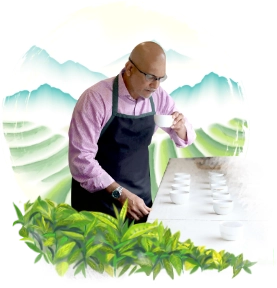Milk first or last? The Science, The Stories…and the Slurping!
The Tea in first (TIF) and the Milk in First (MIF) debate has been raging for more than two centuries, beginning with lively debates and ending with vehement disagreements – generally in the same family at evening dinners! Each side insists their way is the correct way. Each side claims their tea tastes better than others. And each side declares an emphatic victory over the other!
The dispute continues. As George Orwell wrote in 1946, “the best manner of making it is the subject of violent disputes.”
In this blog, we look at science behind TIF and MIF. We recount the amusing stories behind the origin of usage and habit of the milk-first and the milk-last supporters, including how the Queen and the Royal Family have their tea!
Lastly, we tell you the simple secret behind the disgusting slurp, a strict no-no irrespective of whether you are in the populist TIF or the puritan MIF side!

The next time you brew your tea, take a closer look at the pack. Specifically, check out the brewing instructions. I am fairly confident that brewing instructions will end with “ add milk and sugar to taste”. Well, if you have been adding milk last, the good news is that you are with an overwhelming majority…but the bad news is that you might be committing a sacrilege! At least, that is how the tea-puritans, the tea-elitists and the tea-traditionalists would be thinking.
A Nice Cup of Tea
The debate of whether milk should be added last or first got a fresh impetus when George Orwell, the celebrated English novelist, published an essay titled A Nice Cup of Tea in the London Evening Standard on 12th January, 1946. In this much referenced and oft-quoted essay, Orwell discussed the fine art of making a cup of tea, and even laid down 11 rules, “…every one of which I regard as golden”.

It is precisely the tenth golden rule which stirred up a fresh controversy. Contrary to the upper-class, aristocratic and elitist social norms, Orwell openly advocated that milk should be added last, upsetting many refined and blue-blooded gentlemen! He proclaimed :
Tenthly, one should pour tea into the cup first. This is one of the most controversial points of all; indeed in every family in Britain there are probably two schools of thought on the subject. The milk-first school can bring forward some fairly strong arguments, but I maintain that my own argument is unanswerable. This is that, by putting the tea in first and stirring as one pours, one can exactly regulate the amount of milk whereas one is liable to put in too much milk if one does it the other way round.
What does Science have to say?
Researchers have been conducting a lot of experiments in an attempt for settle this age-old argument for once and all. They have found that milk should indeed be added first to the cup, and then tea should be poured in. This is because in case milk is added to tea (which is hot, remember) – the milk gets scalded. As a result, denaturation (degradation) of milk proteins happens as the milk encounters temperatures higher than 75 degrees Celsius! Denaturation means individual drops separate from the bulk of the milk, and the milk is said to get ‘scathed’. This results in a staid and sickly cup of tea.
Other researchers found that when milk was added first, the tea tasted richer. But when milk was added last, it tasted bitter!
According to an article published by the Royal Society of Chemistry a few years ago, “add fresh chilled milk, not UHT milk which contains denatured proteins and tastes bad. Milk should be added before the tea, because denaturation (degradation) of milk proteins is liable to occur if milk encounters temperatures above 75°Celsius. If milk is poured into hot tea, individual drops separate from the bulk of the milk and come into contact with the high temperatures of the tea for enough time for significant denaturation to occur. This is much less likely to happen if hot water is added to the milk. Once full mixing has occurred the temperature should be below 75°Celsius, unless polystyrene cups were used.”
Are you a purist who always puts milk first or an Orwellian who maintains his argument is unanswerable, we would love to hear your story! Here are some amusing TIF and MIF stories :
TIF and MIF Stories
- Tea originated in ancient China. However, the Chinese never had tea with milk. It was only in the late sixteenth century, when tea found its way to the West, that milk started to be added to tea. It is thought that due to lack of proper storage, tea got mouldy and stale during the long journey from China. When brewed in hot water in the West, it tasted very bitter. The addition of milk made the tea much more palatable by diluting the strong-bitterness.
- Another story, continued from the above thread, tells us that tea was extremely valuable and expensive in the West. Therefore, it was used sparingly, ensuring that the stock of tea lasted as long as possible. One way to do this was to add a lot of milk to the tea, and since the West was always rich in dairy, this was the perfect solution. Not only would less tea be used, but the quality of tea could also be camouflaged!
- During the hey days of the British Raj in India, asking for milk-first was always an effective and easy way to kill the bacteria in milk, if the quality of milk was in doubt. It was also used as a subtle and shrewd way of indirectly telling the lady of the house that something was not right with hygiene in her kitchen!

- The arrival of tea in the UK in the eighteenth century ushered in a whole new custom and ritual of showing off expensive porcelain and bone china to show social superiority and class. Expensive porcelain and bone china could only be afforded by the upper-class, who would pour hot tea first. Since top quality bone china did not stain or crack even if hot tea was poured first, it was a clear sign that the family’s status. But there was a problem – soon, cheap low quality imitations started flooding the market. Unlike the top quality bone china used by upper class aristocrats, the questionable quality bone china would either stain or break when hot tea was poured in first!
Imagine pouring hot tea in your esteemed guest in the finest bone china you have , only to find it crack with an embarrassing snap! So, an ingenious way was devised – pour in milk first! This prevented even the low-quality bone china tea ware either cracking or staining.
This solved the bone china problem, but created a never-ending controversy of milk-first or milk-last!
The Queen and the Royal Family – TIF or MIF side?

In an interview to the BBC a couple of years ago, Grant Harrold, the royal butler, finally revealed how tea is served to the posh royal family at Buckingham Palace. Well, there is surprise and disappointment – depending on how you look at it : the royal family are firmly on the TIF side!
Tea is always poured first, and milk is added last, to taste! He confirms the story that since eighteenth century, when Josiah Spode successfully made high-quality china tea-ware in Britain that did not crack when hot tea was poured, the proper way to brew tea has always been tea first, milk last. It was middle-class with cheap bone china who started adding milk so their crockery would not crack!
Ironically, the middle-class Britons today think they are posh by adding in milk first!
Our Take

Today, tea lovers have the choice of brewing loose leaf tea or tea-bags. While connoisseurs prefer the luxury of brewing whole leaf teas in the best china, the always-in-a-hurry start-up founder goes for the quick and convenient tea bag. We suggest milk-first for loose tea purists, and milk-last for tea bags – because generally when a tea bag is brewed in a bigger, cylindrical mug, the heat dissipates faster, and chances of milk scalding are much reduced. Not exactly science, but observation and experience!
Slurping
Ever been around someone slurping their tea? Remember how people around looked gave a disgusting and disapproving look? Manners…etiquette!
Slurping happens when someone is trying to drink tea that is really hot. Drinking tea at higher temperatures requires the drinker to suck in air with the tea, creating a somewhat air-cooling effect on the tongue. The sound of air and tea sucked in together creates a noise that is commonly known as slurping.
The ideal temperature to enjoy hot tea is between 60 to 65 degrees Celsius, which is reached within about a minute to 90 seconds after the tea is poured. Another effective way to cool off the tea is leaving a teaspoon in the tea for a few seconds (the spoon absorbs the heat, cooling the tea faster – basic physics at play!)
I hope you enjoyed reading about this fascinating TIF versus MIF debate. The world of tea is full of such amazing and amusing stories. Join us as keep unravelling the unending tales of magic, mysteries and mystique of this most wonderful of beverages!

Tea is a religion in the art of life.

